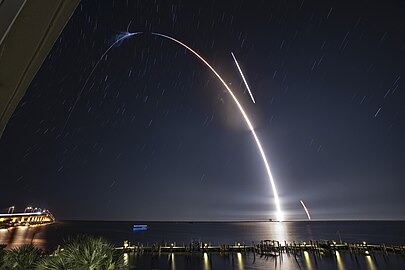 The SpaceX CRS-17 Dragon approaching to the ISS for RMS capture. The SpaceX CRS-17 Dragon approaching to the ISS for RMS capture. | |
| Names | SpX-17 |
|---|---|
| Mission type | ISS resupply |
| Operator | SpaceX |
| COSPAR ID | 2019-025A |
| SATCAT no. | 44222 |
| Mission duration | 30 days, 14 hours, 22 minutes |
| Spacecraft properties | |
| Spacecraft | Dragon 1 C113 |
| Spacecraft type | Dragon 1 |
| Manufacturer | SpaceX |
| Dry mass | 4,200 kg (9,300 lb) |
| Payload mass | 2,482 kg (5,472 lb) |
| Dimensions | Height: 6.1 m (20 ft) Diameter: 3.7 m (12 ft) |
| Start of mission | |
| Launch date | 4 May 2019, 06:48 UTC |
| Rocket | Falcon 9 Block 5 (B1056.1) |
| Launch site | Cape Canaveral, SLC-40 |
| End of mission | |
| Disposal | Recovered |
| Landing date | 3 June 2019, 21:10 (2019-06-03UTC21:11) UTC |
| Landing site | Pacific Ocean off Baja California |
| Orbital parameters | |
| Reference system | Geocentric |
| Regime | Low Earth |
| Inclination | 51.6° |
| Berthing at ISS | |
| Berthing port | Harmony nadir |
| RMS capture | 6 May 2019, 11:04 UTC |
| Berthing date | 6 May 2019, 13:33 UTC |
| Unberthing date | 3 June 2019 |
| RMS release | 3 June 2019, 16:01 UTC |
| Time berthed | 27 days |
 NASA SpX-17 mission patch Commercial Resupply Services← NG-11SpaceX CRS-18 → Cargo Dragon← SpaceX CRS-16SpaceX CRS-18 → | |
SpaceX CRS-17, also known as SpX-17, was a Commercial Resupply Services mission (CRS) to the International Space Station that was launched aboard a Falcon 9 rocket on 4 May 2019. The mission was contracted by NASA and was flown by SpaceX. An umbilical connection from the strongback remained attached to the spacecraft and is visible in photos taken of it approaching & attached to the ISS.
Launch schedule history
In February 2016, it was announced that NASA had awarded a contract extension to SpaceX for five additional CRS missions (CRS-16 to CRS-20). In June 2016, a NASA Inspector General report had this mission manifested for October 2018, but by January 2019 this had been pushed back to April 2019.
Due to a Dragon 2 test anomaly on 20 April 2019, SpaceX needed to acquire a permit to allow landing on the drone ship, "Of Course I Still Love You". The ship was stationed just 28 kilometres (17 mi) downrange "to ensure the integrity of the area and preserve valuable information".
Primary payload
Total weight of the cargo on the CRS-17 mission was 2,482 kg (5,472 lb), consisting of 1,517 kg (3,344 lb) in the pressurized section and 965 kg in the unpressurized section.
Cargo in unpressurized section included the Orbiting Carbon Observatory 3 (OCO-3) and STP-H6.
Gallery
SpaceX CRS-17-
 Launch of CRS-17
Launch of CRS-17
-
 Falcon 9 exiting the atmosphere
Falcon 9 exiting the atmosphere
-
 Long exposure image of launch
Long exposure image of launch
-
 Dragon approaches the ISS
Dragon approaches the ISS
-
 Dragon grappled by the ISS
Dragon grappled by the ISS
See also
References
- Clark, Stephen (24 April 2019). "Launch schedule". SpaceFlight Now. Retrieved 1 May 2019.
- Bergin, Chris (3 June 2019). "CRS-17 Dragon returns home from ISS mission". NASA SpaceflightNow. Retrieved 31 August 2019.
- @SpaceX (6 May 2019). "Capture confirmed! Dragon is now attached to the @Space_Station robotic arm" (Tweet) – via Twitter.
- @SpaceX (4 Jun 2019). "Dragon has been released from the @Space_Station! Three departure burns are now underway" (Tweet) – via Twitter.
- "Rocket Launch: 30 April 2019, 04:22 ET | SpaceX Falcon 9 CRS-17". blogs.nasa.gov. Retrieved 2019-04-23.
- David Todd (May 8, 2019). "Dragon CRS-17 launched by Falcon 9 to later dock with ISS but umbilical separation failure raises major questions". Retrieved May 30, 2023.
- de Selding, Peter B. (24 February 2016). "SpaceX wins 5 new space station cargo missions in NASA contract estimated at $700 million". Space News. Retrieved 24 February 2016.
- NASA Office of Inspector General (28 June 2016). NASA's Response to SpaceX's June 2015 Launch Failure: Impacts on Commercial Resupply of the International Space Station (PDF) (Report). NASA Office of Inspector General. p. 13. Retrieved 18 July 2016.
- "Upcoming Missions". SpaceXNow.com. Retrieved 8 January 2019.
- "FCC Application for special temporary authority". 22 April 2019. Retrieved 23 April 2019.
- "NASA moves ahead with cargo Dragon launch after Crew Dragon anomaly". 22 April 2019. Retrieved 24 April 2019.
- ^ "SpaceX CRS-17 Mission Overview" (PDF). NASA. Retrieved 20 June 2019.
External links
- [REDACTED] Media related to SpaceX CRS-17 at Wikimedia Commons
- NASA
- SpaceX official page for the Dragon spacecraft
- Launch date update
- https://www.youtube.com/watch?v=QmvY8ZmN0Ic
| SpaceX Dragon 1 and Dragon 2 | |||||||
|---|---|---|---|---|---|---|---|
| Spacecraft |   | ||||||
| Hardware | |||||||
| Missions |
| ||||||
| |||||||
| SpaceX missions and payloads | |||||||||||||||||||||
|---|---|---|---|---|---|---|---|---|---|---|---|---|---|---|---|---|---|---|---|---|---|
| Launch vehicles | |||||||||||||||||||||
| Falcon 1 missions |
| ||||||||||||||||||||
| Falcon 9 missions |
| ||||||||||||||||||||
| Falcon Heavy missions |
| ||||||||||||||||||||
| Starship missions |
| ||||||||||||||||||||
| |||||||||||||||||||||
| Uncrewed spaceflights to the International Space Station | ||
|---|---|---|
| ||
| 2000–2004 |  | |
| 2005–2009 | ||
| 2010–2014 | ||
| 2015–2019 | ||
| 2020–2024 | ||
| Future | ||
| Spacecraft | ||
| ||